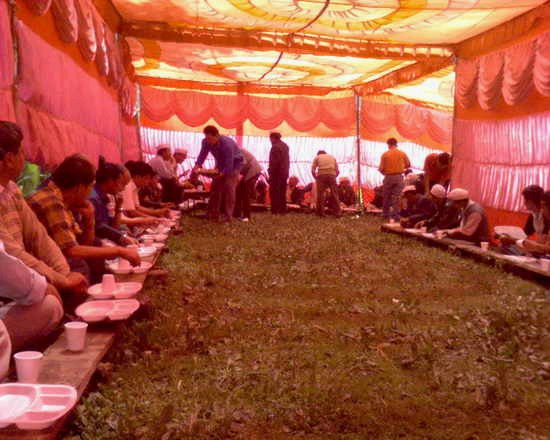In 1967, the Government of India notified the 'Shaukas' (Bhotiyas) under the Scheduled Tribes Act which enabled those of the younger generation to avail of formal education and subsequent job reservations. The trade depot of Munsyari, situated at the foot of the Panchachuli range about 50 miles South of the Tibetan frontier, evolved into a town with government schools, colleges and administrative centres. Nearly all the Shaukas abandoned their highland villages, once strategically close to Tibet but now remote and cutoff from the mainstream, and settled close to Munsyari. Young Shauka men availed of job reservations given to them by the government and migrated permanently to cities in the plains, taking their families with them.
Meanwhile, those who remained out of necessity or choice in the mountains faced a difficult future. Many shepherds sold their entire flocks to meat markets and those who did not found it increasingly difficult to sustain their animals with the limited grazing available in depleted forests. For it was during the seventies and eighties that maximum damage was done to the natural resources of Kumaon as more and more timber was required to feed paper mills and other factories in the plains. The women, not only of the Shauka tribe but of all the hill communities, suffered the most as fuelwood and fodder became scarce and water sources dried up.
As part of the development programme for the region, the government did eventually supply Shauka women with wool. Unfortunately, the wool was of a very poor quality, mill spun and dyed in awful chemical colours like shocking pink and canary yellow, and was brought up from Punjab and Delhi. This arrangement created an ideal setting for middlemen of all kinds to exploit the weavers. Policy makers ignored the fact that a good marketing system was also required, as a result of which the same middlemen who sold the weavers woolen yarn on cash basis collected the finished products from them on credit basis. The women felt they were being thoroughly exploited, and gradually lost interest in their craft to such an extent that by the nineties only few women still knew and practiced traditional methods of dyeing and weaving.
On the other hand, in order to bring in cash, the Shauka men used their guns, once meant solely to protect their caravans from dacoits and predators, to kill rare musk deer, snow leopard, black bear and other species. The musk, and pelts sold at large profits on the black market. (To make matters worse, bored army personnel who were stationed near the Tibetan frontiers shot Blue Sheep and Thar, a sort of Ibex, at random for meat and sport). Similarly, highland forests of cedar and spruce were also depleted and the valuable timber sold.
In an unexpected turn of events, an agreement was signed between the Governments of India and China in 1992 and the re-opening of the Lipu la pass for trans-Himalayan trade was a part of that accord. For the Shaukas of the older generation, returning to Tibet after a gap of almost 35 years was an emotional event. Although they were shocked to see that the great monastery of Purang and smaller Gompas around Mount Kailash had been razed to the ground by the Chinese army, some Shaukas were fortunate enough to be reunited with their old trade partners at Gangtok and Gyanima. They returned to India with some quantities of Tibetan goat pashmina (the fine undercoat of high altitude animals) renowned for its warmth and softness, Bactrian camel wool, and fine Tibetan sheep wool. Although rock salt, borax, gold dust and turquoise had been replaced by cheap electronic and plastic goods made in China, wool was still available from the Khampa and Dokpa nomads.
Over the years, the Shauka community has expanded, migrated, and readapted to present day life. Rapid modernization, almost feverish in its haste and devoid of sound planning and devoid of sound planning and vision, has brought a curious mixture of development and destruction to the mountains. In this fast changing world, the ancient trade routes across the alpine pastures, swift flowing rivers and glacial rubble of Johar, over the desolate, austere passes and into the great plains of Tibet with its turquoise lakes and cobalt sky, remain eternal, unchanging. Perhaps it is time to pause and reflect upon the wisdom and skills of the traditions of the tribal people and turn this knowledge to the advantage of the Shauka community. For the time is not far when the tranquil highlands of Kumaon will be flooded by mass tourism. This will open avenues for further exploitation of the natural and man made resources of the Shaukas by a new set of middlemen.
Before this happens, it is imperative that these resources are put firmly in the control of the indigenous communities, and such traditional skills as weaving and growing up medicinal plants can help to make the Shaukas economically self-sufficient without damaging the environment on both a long and short term basis. The high Himalayas are rich in resources and though they seem inhospitable and desolate to the uninitiated, they support an amazing variety of plant and animal life and have sustained communities such as the Shaukas of Kumaon in innumerable valleys from Kashmir to Bhutan, across the length of Northern India and Nepal. The re-opening of trans-Himalayan trade provides many opportunities to the Shaukas to return to a traditional way of life which can be made economically, socially and environmentally relevant and profitable.
Thursday, May 15, 2008
Subscribe to:
Post Comments (Atom)



No comments:
Post a Comment